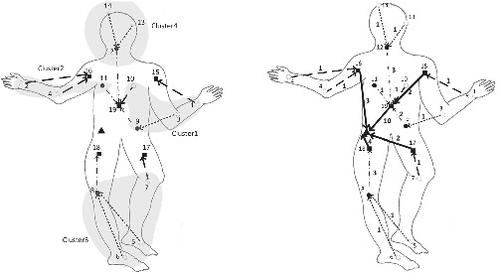当前位置:
X-MOL 学术
›
Int. J. Commun. Syst.
›
论文详情
Our official English website, www.x-mol.net, welcomes your
feedback! (Note: you will need to create a separate account there.)
Relay selection, clustering, and data aggregation routing in wireless body area networks
International Journal of Communication Systems ( IF 1.7 ) Pub Date : 2021-04-29 , DOI: 10.1002/dac.4837 Negin Ziaei 1 , Avid Avokh 1
International Journal of Communication Systems ( IF 1.7 ) Pub Date : 2021-04-29 , DOI: 10.1002/dac.4837 Negin Ziaei 1 , Avid Avokh 1
Affiliation

|
This paper addresses the problems of relay selection, clustering, and routing to extend the lifetime of wireless body area networks. We first propose an efficient algorithm called “Energy-aware Relay Selection and Cluster-based Routing (ERSCR)” to develop a hybrid data aggregation tree in the network. ERSCR has three phases, including the relay selection, clustering and Cluster Head (CH) selection, and data transmission. It divides the biosensors into several clusters and selects an appropriate CH for each cluster. Each biosensor transmits data to its CH or relay node. The aggregated data are then routed to the sink through an energy-balanced routing tree. The proposed scheme considers both residual energy and distance for routing data of biosensors. It not only reduces the energy consumption in the network but also balances the energy consumed by different biosensors. Subsequently, we improve the ERSCR algorithm and introduce the “Joint Relay Selection, Clustering, and Routing (JRSCR)” algorithm to achieve a better network performance. JRSCR benefits from the advantages of the ERSCR algorithm. Moreover, it reduces the number of transmissions with the direct use of the relay nodes as CH. As another advantage, both ERSCR and JRSCR algorithms are compatible with the natural physical states of the human body. Simulation results demonstrate the efficiency of the proposed algorithms in terms of energy consumption, network lifetime, and maximum hop count.
中文翻译:

无线体域网中的中继选择、集群和数据聚合路由
本文解决了中继选择、聚类和路由问题,以延长无线体域网的使用寿命。我们首先提出了一种称为“能量感知中继选择和基于集群的路由(ERSCR)”的高效算法,以在网络中开发混合数据聚合树。ERSCR 分为三个阶段,包括中继选择、分簇和簇头(CH)选择以及数据传输。它将生物传感器分成几个集群,并为每个集群选择一个合适的 CH。每个生物传感器将数据传输到其 CH 或中继节点。然后通过能量平衡路由树将聚合数据路由到接收器。所提出的方案考虑了生物传感器路由数据的剩余能量和距离。它不仅减少了网络中的能源消耗,而且平衡了不同生物传感器消耗的能源。随后,我们改进了 ERSCR 算法并引入了“联合中继选择、聚类和路由(JRSCR)”算法,以实现更好的网络性能。JRSCR 受益于 ERSCR 算法的优点。此外,它减少了直接使用中继节点作为 CH 的传输次数。作为另一个优点,ERSCR 和 JRSCR 算法都与人体的自然物理状态兼容。仿真结果证明了所提出算法在能耗、网络寿命和最大跳数方面的效率。和路由(JRSCR)”算法以实现更好的网络性能。JRSCR 受益于 ERSCR 算法的优点。此外,它减少了直接使用中继节点作为 CH 的传输次数。作为另一个优点,ERSCR 和 JRSCR 算法都与人体的自然物理状态兼容。仿真结果证明了所提出算法在能耗、网络寿命和最大跳数方面的效率。和路由(JRSCR)”算法以实现更好的网络性能。JRSCR 受益于 ERSCR 算法的优点。此外,它减少了直接使用中继节点作为 CH 的传输次数。作为另一个优点,ERSCR 和 JRSCR 算法都与人体的自然物理状态兼容。仿真结果证明了所提出算法在能耗、网络寿命和最大跳数方面的效率。
更新日期:2021-06-03
中文翻译:

无线体域网中的中继选择、集群和数据聚合路由
本文解决了中继选择、聚类和路由问题,以延长无线体域网的使用寿命。我们首先提出了一种称为“能量感知中继选择和基于集群的路由(ERSCR)”的高效算法,以在网络中开发混合数据聚合树。ERSCR 分为三个阶段,包括中继选择、分簇和簇头(CH)选择以及数据传输。它将生物传感器分成几个集群,并为每个集群选择一个合适的 CH。每个生物传感器将数据传输到其 CH 或中继节点。然后通过能量平衡路由树将聚合数据路由到接收器。所提出的方案考虑了生物传感器路由数据的剩余能量和距离。它不仅减少了网络中的能源消耗,而且平衡了不同生物传感器消耗的能源。随后,我们改进了 ERSCR 算法并引入了“联合中继选择、聚类和路由(JRSCR)”算法,以实现更好的网络性能。JRSCR 受益于 ERSCR 算法的优点。此外,它减少了直接使用中继节点作为 CH 的传输次数。作为另一个优点,ERSCR 和 JRSCR 算法都与人体的自然物理状态兼容。仿真结果证明了所提出算法在能耗、网络寿命和最大跳数方面的效率。和路由(JRSCR)”算法以实现更好的网络性能。JRSCR 受益于 ERSCR 算法的优点。此外,它减少了直接使用中继节点作为 CH 的传输次数。作为另一个优点,ERSCR 和 JRSCR 算法都与人体的自然物理状态兼容。仿真结果证明了所提出算法在能耗、网络寿命和最大跳数方面的效率。和路由(JRSCR)”算法以实现更好的网络性能。JRSCR 受益于 ERSCR 算法的优点。此外,它减少了直接使用中继节点作为 CH 的传输次数。作为另一个优点,ERSCR 和 JRSCR 算法都与人体的自然物理状态兼容。仿真结果证明了所提出算法在能耗、网络寿命和最大跳数方面的效率。











































 京公网安备 11010802027423号
京公网安备 11010802027423号